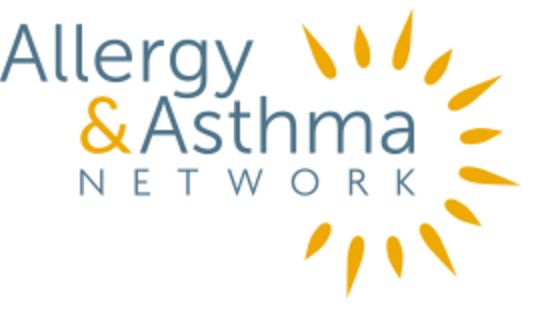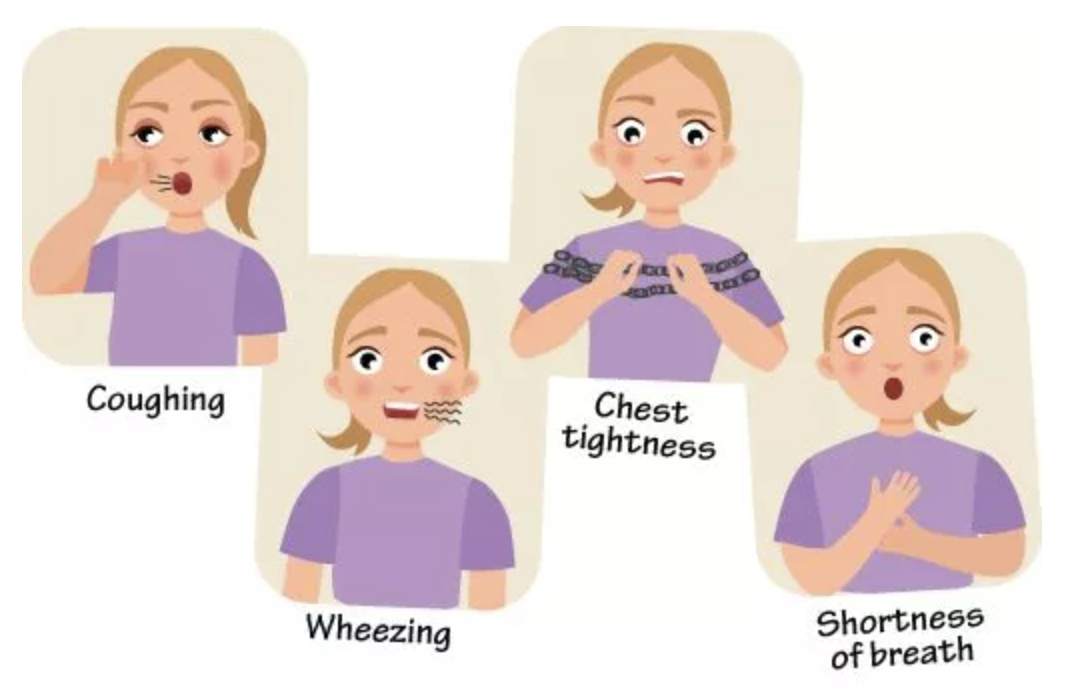When you understand the signs of asthma and what can trigger asthma symptoms, you take a step toward controlling your disease. You take a step toward improving your daily life and overall well-being.
What are common asthma symptoms in infants, children, teens and adults? What is in your environment that may be an asthma trigger? Take a closer look at asthma symptoms and triggers and be sure to include them in your Asthma Action Plan.
Common asthma symptoms include:
- Coughing: An asthma cough is often worse at night or early morning. Sometimes it’s your only symptom. It can be dry or mucus filled.
- Wheezing: This is a whistling sound or squeaky sound especially when you breathe out. Sometimes wheezing can be heard easily; other times you need a stethoscope. A stethoscope is a medical device used to listen to breath sounds.
- Chest tightness: This can feel like something is squeezing or sitting on your chest.
- Shortness of breath: You may feel breathless, like you can’t catch your breath or breathe deeply enough. You may feel as though you are out of shape and constantly tired.
What triggers asthma symptoms?
It is important to understand what triggers your asthma symptoms. Asthma is not a one-size-fits-all disease – what sets off symptoms for you or someone in your family may be quite different from what affects others. When you understand what’s happening inside your lungs and how they respond to allergens and irritants like pollen, dust mites or smoke, you can take steps to prevent or minimize symptoms.
Common asthma triggers include:
- Indoor allergens: mold, pet dander, dust mites, cockroaches
- Outdoor allergens: pollen, mold
- Irritants: secondhand smoke, diesel exhaust, air pollution
- Respiratory viruses: colds, flu, sinus infections
- Exercise
- Stress
- Cold air or sudden changes in temperature
- Strong smells
- Strong emotions such as laughing or crying
- Hormonal changes
Asthma symptoms in adults
Asthma affects people of all ages including adults. Some may experience adult-onset asthma symptoms, or symptoms that first occur in adulthood. Asthma in adults can vary in severity and intensity. In addition to common symptoms of coughing, wheezing, chest tightness and shortness of breath, adults may experience:
- Fatigue: asthma can cause fatigue or a general feeling of low energy. This can be due to the extra effort required to breathe.
- Difficulty sleeping: asthma symptoms can worsen at night, leading to disrupted sleep. If asthma wakes you up more than twice a month, this is a sign of uncontrolled asthma.
- Increased mucus production: asthma can cause excess mucus, which may be coughed up or felt as phlegm in the throat.
- Exercise-induced symptoms: some adults with asthma may have worsened symptoms during or after physical activity. Exercise-induced asthma (EIA), also called exercise-induced bronchoconstriction (EIB), is a condition where the airways narrow during or shortly after exercise.
Asthma symptoms in teens
Asthma can have a significant impact on teenagers. It can affect their physical, emotional, and social well-being. It can be particularly disruptive during activities like sports, exercise, or even simply walking between classes. These limitations may lead to frustration and reduced participation in activities.
In addition to common symptoms, teens may also experience tiredness or fatigue, excess mucus production, difficulty sleeping and EIB.
Parents, caregivers and doctors should monitor teens’ mental health. Managing asthma, in addition to schoolwork and social stressors, can feel overwhelming. Hospital visits due to asthma and the need to carry inhalers can make teenagers feel different from their peers. This could lead to feelings of embarrassment, self-consciousness, exclusion, isolation and frustration.
Asthma symptoms in babies and children
Most people with asthma are first diagnosed with the condition in the first 10 years of life. In infants and toddlers and preschoolers, it can be hard for parents and sometimes doctors to diagnose a child’s asthma. This is because their bronchial tubes are small and narrow. Illnesses, allergens and irritants can irritate their airways, making them even smaller.
Symptoms of asthma in babies and children can vary. It’s hard to monitor symptoms in infants because they are unable to communicate how they are feeling or what they are experiencing.
In addition to common symptoms, babies and children with asthma may display other related symptoms:
- Fast, shallow breathing (an increased respiratory rate)
- Fussiness
- Fatigue or decreased activity
- Bellies move more when inhaling or exhaling
- Nostrils open up when breathing
- Symptoms worse at night
- Problems eating
- Recurrent respiratory infections
- Blue tint to skin and fingernails – a sign of an asthma attack
- Environmental allergies and/or food allergies
Allergy, asthma and other respiratory conditions often coexist. Children with eczema, environmental allergies and food allergies may be at higher risk of developing asthma.
Asthma symptoms in pregnancy
Asthma is a common chronic disease in pregnancy. Some may experience worse asthma symptoms, some may experience improved symptoms, and some will have no change at all. Pregnant women previously diagnosed with severe asthma are more likely to have worse asthma symptoms.
Healthy breathing is vital to a healthy pregnancy and healthy baby. Your unborn baby depends on you for oxygen. Asthma symptoms during pregnancy could mean you and your baby may not be getting enough oxygen. Poorly controlled asthma puts you at increased risk for complications. This can endanger the health of both the mother and unborn baby.
Symptoms that indicate your asthma is in the danger zone and you should get immediate medical help or call 9-1-1:
- your breathing does not improve in response to quick-relief medication;
- you notice reduced fetal movements;
- you have difficulty breathing and your asthma medicines do not help;
- headaches;
- vomiting;
- vaginal bleeding.
Are the symptoms different between mild, moderate and severe asthma?
Symptoms of mild, moderate and severe asthma can differ. Asthma is very individualized, so there may be some overlap. Here are symptoms for each:
Mild Asthma
- Symptoms occur a couple times a week but less than once a day.
- Symptoms may awaken you at night 1-2 times a month.
- Lung function is usually normal between episodes but may be slightly reduced.
- Episodes may last a few days and may affect daily activities.
- Symptoms are usually controlled with quick-relief inhalers but may require additional long-term control medications.
Moderate Asthma
- Symptoms occur daily.
- Symptoms may awaken you at night more than once a week but not every night.
- Lung function is reduced, and airflow limitation may be present.
- Episodes may last several days, occur frequently, and may interfere with daily activities.
- Symptoms often require regular use of long-term control medications, in addition to quick-relief inhalers.
Severe Asthma
- Symptoms occur throughout the day.
- Symptoms may awaken you at night frequently.
- Lung function is significantly reduced, with frequent airflow limitations.
- Episodes can last for days or weeks and severely limit daily activities.
- Symptoms often require high-dose, long-term control medications and frequent use of quick-relief inhalers.
Does humidity affect asthma?
Humidity in the air is a common asthma trigger. It contains moisture that makes the air heavier and denser. It can also cause the air to be stagnant. This makes it harder for people with asthma to breathe efficiently. Humidity combined with hot weather can activate sensory nerve fibers in the airways, causing them to narrow. This can lead to asthma symptoms. Humidity also creates an environment where air pollutants and allergens such as pollen and mold linger in the air — and potentially lead to a severe attack.
What are common asthma attack symptoms?
If your symptoms suddenly worsen, you may be having an asthma attack. Any of these signs indicate the need for immediate medical treatment.
- Symptoms don’t respond when you take a quick-relief medication.
- It feels like you can’t catch a good deep breath or can’t get the air out of your chest.
- You can’t talk except in short phrases.
- You have a cough that will not stop, or you simply feel too exhausted to breathe.
- Your shoulders tense and raise closer to your ears than normal.
- It’s easier to breathe while sitting and leaning forward than when lying down.
- Your fingernails turn blue, or your lips become bluish or gray in color.
- You start sweating even though your skin feels clammy and cold.
- The skin around your chest, ribs and collarbones sinks in with each breath and you’re using stomach muscles to help you breathe.
- You experience swelling of your throat, tongue or limbs.
Using a peak flow meter can help you identify the early warning signs of an asthma attack. A peak flow meter is a handheld device that measures Peak Expiratory Flow Rate (PEFR). This is the maximum speed you can force air out of your lung’s large airways. PEFR can show how well your lungs are working.
Follow your Asthma Action Plan when symptoms occur or for asthma flare-ups. Call 9-1-1 for severe episodes.
Patient education resources from Allergy & Asthma Network

© 2021 Allergy and Asthma Network
Last updated : 6/26/2024
